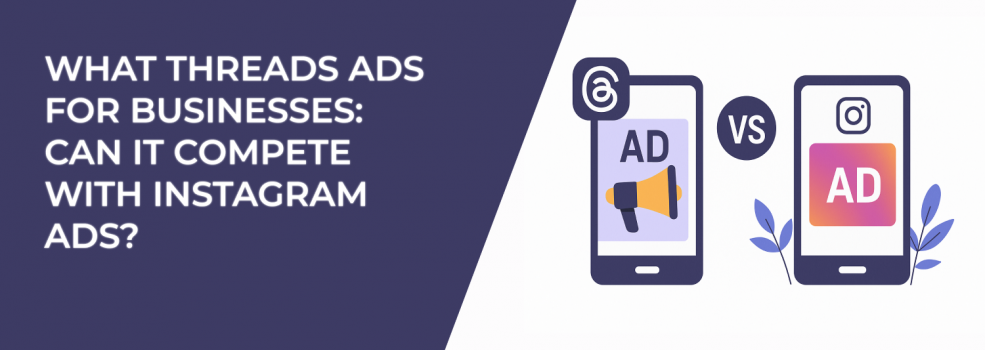Meta has quietly rolled out a new ad channel — Threads ads. These are now available through the Instagram Ads Manager, and they’re already stirring up interest in the advertising world. But are they actually useful for marketers, or are they just another experimental feature that will fade out?
If you’re investing time and budget in Instagram ads, it’s natural to wonder if Threads is worth testing. Let's take a close, practical look at what Threads ads offer and where they stand in comparison to Instagram.
What Exactly Are Threads Ads?
Threads is Meta’s text-first social app, positioned as an alternative to X (formerly Twitter). Unlike Instagram, it focuses on conversations over visuals.
In late 2024, Meta introduced ads in Threads, placing them within the For You feed. They appear between organic posts as users scroll through personalized content. What’s interesting is that Threads ads use the same infrastructure as Instagram. You can launch them directly from the Ads Manager you're already familiar with — using the same objectives, audiences, and creative settings.
That makes testing fairly easy. But the platform’s layout and user behavior are very different, so the ads perform differently too.
If you’re not confident in how campaign goals impact outcomes across platforms, take time to review Meta Ad Campaign Objectives Explained: How to Choose the Right One. It can help you select smarter objectives whether you're advertising on Instagram, Threads, or both.
When Threads Might Make Sense for Your Brand
Threads isn’t for everyone. If you're selling impulse-buy products through eye-catching videos, Instagram is still the stronger option. But Threads has some early advantages that make it worth exploring.
Here are a few use cases where Threads might fit:
-
Brand building through voice and thought leadership. Since Threads is focused on conversation, brands with a clear tone and message can stand out quickly.
-
Targeting curious, early adopter audiences. Threads users tend to engage more deeply with ideas, discussions, and questions — not just visuals.
-
Complementing your Instagram campaigns. You don’t have to run Threads ads as a separate campaign. Add it as a placement and test messaging formats across both platforms.
You won’t get the same direct response results here, but you might gain exposure in a less crowded space.
What You Can Do With Threads Ads Right Now
While the options are limited compared to Instagram, Threads does offer some key advertising features through Meta’s ad system. Here's what’s available today:
Threads supports:
-
Feed-only placement: Ads appear in the “For You” timeline, not in follower-only feeds or search.
-
Standard campaign objectives: You can choose awareness, traffic, engagement, or app installs.
-
Cross-platform targeting: Use your existing Meta custom or lookalike audiences to reach users across both Instagram and Threads.
-
Performance reporting: Threads ads report back in Ads Manager just like other placements.
That said, Threads doesn’t support all formats yet. Video options are limited. There’s no Reels-style placement. And you won’t find direct shopping tags or advanced product catalog integrations — at least not yet.
Threads Ads vs Instagram Ads: The Practical Differences
Instagram ads are optimized for high-performance results. You can run story takeovers, Reels, shopping campaigns, carousel ads, and more — all tailored for conversions.
Threads isn’t there yet. Its focus is still on engagement and discovery. So comparing them side by side is more about strategy than features.
If you’re weighing performance across platforms, take a look at Instagram Ads vs Facebook Ads: Which Is Better for Your Business?. It breaks down how each one fits different campaign goals and buyer journeys.
And if you're experimenting with video formats, especially Reels, your creative approach matters. Learn how to make the most of this format in How to Use Instagram Reels in Your Marketing Strategy, which outlines both organic and paid tactics that boost engagement.
Key differences to know:
-
Ad real estate: Instagram offers more placements. Threads has just one — the main feed.
-
User expectations: Threads users expect posts to feel conversational. Instagram users are more tolerant of polished, visual advertising.
-
Conversion behavior: Instagram encourages clicks, swipes, and purchases. Threads is better suited to brand recall and top-of-funnel awareness.
If you want immediate ROAS, Threads might not deliver. But if you want to test new messaging, learn how people respond to your brand voice, or build a long-term brand image, it’s a useful space.
Struggling with results on Instagram or Facebook? You may want to revisit your audience or messaging strategy. Facebook Ads Not Converting: How To Fix It offers a deep dive into troubleshooting common issues with performance campaigns.
How to Build Threads Ads That Don’t Look Like Ads
Users on Threads are wary of overt marketing. Your content should feel native, not like it was dropped in from another platform. You’ll need to adapt both your message and format.
To make your Threads ads feel natural and effective:
-
Lead with text that starts a conversation. Ask a question, challenge a norm, or offer a short insight. Threads is all about engaging statements that spark replies.
-
Use simple visuals or none at all. A single image can work, but don’t rely on videos or slideshows. Keep the focus on your words.
-
Avoid heavy branding. The less your ad looks like an ad, the better. Stick to subtle logos or brand cues, and focus on tone.
-
Be timely and relevant. Tap into trending topics or industry news to make your ad feel current and responsive.
This approach takes more effort, but the payoff is higher authenticity — and potentially stronger engagement.
Practical Testing Strategy: How to Try Threads Without Risk
You don’t need to move half your budget into Threads to learn something useful. A small, targeted test can reveal a lot.
Start with a low-risk test like this:
-
Pick one existing Instagram campaign that’s focused on awareness or engagement.
-
Duplicate it, and include Threads as an additional placement.
-
Limit your Threads budget to 5–10% of the campaign total.
-
Customize your ad creatives with a more text-based layout and messaging.
-
Compare results after 7–10 days, focusing on CPM, CTR, and time spent on site (if applicable).
Make sure to tag your links with custom UTMs so you can isolate Threads traffic in your analytics platform.
If you haven’t defined your core segments yet, check out How to Define a Target Audience for Marketing: a Step-by-Step Guide. Getting your targeting right is key to valid test results.
Should You Use Threads Ads?
If your brand depends on performance ads and ROI tracking, Threads won’t replace Instagram — not yet. But if you're experimenting with brand storytelling, reaching new audiences, or finding fresh angles for engagement, it’s a useful testing ground.
It’s not just about advertising. It’s about learning how people interact with your ideas in a different social context.
If your Threads test goes well, you might consider increasing the budget gradually. For best practices on how to do that without killing your ROI, check out Scaling Instagram Ads While Maintaining ROI: What You Need to Know. It outlines pacing strategies, creative testing, and what metrics to track as you scale.
So yes — Threads ads can compete, but only in the right context and with the right expectations.

